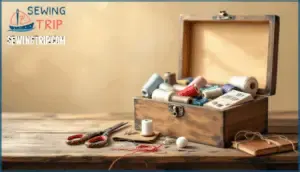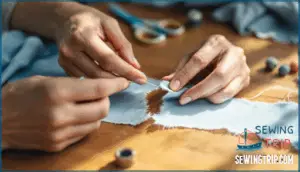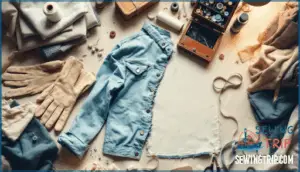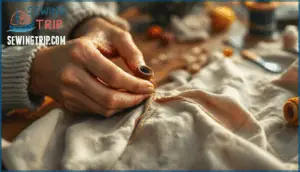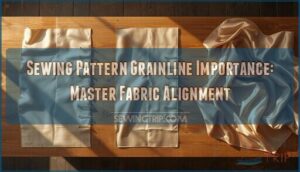This site is supported by our readers. We may earn a commission, at no cost to you, if you purchase through links.
 That favorite sweater with the small tear, the work pants developing a hole at the seam, the tote bag slowly unraveling at the edge—these aren’t beyond saving. Most people assume damaged fabric means the trash, but hand stitching offers a path forward that’s genuinely within reach, even for beginners.
That favorite sweater with the small tear, the work pants developing a hole at the seam, the tote bag slowly unraveling at the edge—these aren’t beyond saving. Most people assume damaged fabric means the trash, but hand stitching offers a path forward that’s genuinely within reach, even for beginners.
The methods you’re about to learn have been used by textile conservators and skilled menders for centuries, refined not through marketing but through actual wear and washing. What makes hand stitching different from patching or replacing isn’t just cost; it’s control. You choose how visible the repair becomes, how strong it needs to be, and whether it transforms into something intentional and beautiful.
The techniques that follow break down into patterns you can master one repair at a time.
Table Of Contents
- Key Takeaways
- Assessing Fabric Damage for Repair
- Essential Tools for Hand Stitching
- Building a Compact Sewing Repair Kit
- Preparing Fabric Before Stitching
- Basic Hand Stitching Methods Explained
- Step-by-Step Repairs for Common Issues
- Reinforcing and Finishing Your Repairs
- Creative and Sustainable Mending Techniques
- Frequently Asked Questions (FAQs)
- Conclusion
Key Takeaways
- Hand stitching lets you control repair visibility, strength, and appearance—choosing between invisible mends that preserve original aesthetics or visible repairs that celebrate garment history and durability.
- Different damage types (clean tears, jagged rips, holes, seam failures) require specific stitches and techniques; matching repair method to damage type ensures 90%+ fabric strength retention and prevents premature re-tearing.
- Proper preparation—cleaning, pressing, pinning, and matching thread to fabric weight—improves stitch integrity by up to 30% and is just as critical as the stitching technique itself for lasting repairs.
- Hand stitching extends garment life by 1.5–3 years while cutting carbon emissions 20–40% per item compared to replacement, transforming mending into a sustainable practice that diverts textiles from the 92 million tonnes dumped annually into landfills.
Assessing Fabric Damage for Repair
Before you start stitching, you need to understand what you’re working with—different damage types require different approaches. The fabric’s condition will guide your choice of stitch, thread, and whether you’ll hide the repair or make it part of your garment’s story.
Let’s walk through the key factors that determine your repair strategy.
Identifying Tear Types (Clean, Jagged, Holes, Seams)
Not all tears are created equal. Understanding what you’re dealing with—whether it’s a clean linear tear, jagged damage, a hole, or seam failure—determines your repair strategy and success rate.
Tear types you’ll encounter:
- Clean tears run along fabric yarns, accounting for 35–50% of repairs, and respond beautifully to ladder or whipstitch methods
- Jagged tears (20–30% of damage) have irregular, frayed edges that need trimming to prevent rapid re-tearing
- Holes from punctures or abrasion (15–22% of repairs) typically need patching, especially in high-wear zones like elbows
- Seam failures (18–24%) occur under repeated stress and require reinforcement stitching for durability
- Fabric fraying indicates edge damage; smoothing frayed fibers before stitching improves results by up to 35%
Visual inspection under bright light catches most damage, though magnification helps distinguish fine details. Run your fingers along edges to feel fraying—tactile assessment reveals what your eyes might miss and guides your seam inspection technique for hand sewing stitches that actually grip.
Effective tear repair methods are vital for maintaining fabric integrity.
Evaluating Tear Size and Location
Size matters more than you’d think. Tears under 2.5 cm respond well to simple hand sewing stitches and retain up to 90% of fabric strength, while larger damage needs patching for durability. Grain direction affects stitch optimization: parallel tears keep 80% strength versus 60% for diagonal damage.
Location shapes your repair planning too—high-stress zones like elbows and knees fail 45% faster after washing, so reinforce heavily there. Tears near seams gain a 25% strength boost by utilizing existing stitching.
Document tear size, orientation, and location before selecting your technique for hole repair and fabric stress management. Using the right fusible interfacing method can greatly improve the effectiveness of your repair.
Deciding on Repair Visibility
Now you’ll choose between invisible and visible mending—and that choice shapes everything. Hidden repairs suit formal wear and delicate fabrics where you want flawless restoration, while visible mending turns damage into storytelling.
Think of it this way: invisible work preserves the original aesthetic, but visible techniques create a narrative of care and sustainability. Research shows 67% of people prefer seeing repairs as marks of authenticity.
Your fabric type matters too—denim welcomes bold stitching, but silk prefers discretion. Consider your garment’s future use and what feels right to you.
Essential Tools for Hand Stitching
Getting started with hand stitching doesn’t require much—just a few key items that’ll give you control and confidence with every repair. The tools you choose make a real difference in how smoothly your project goes and how professional your finished work looks.
Let’s walk through what you actually need to have on hand.
Choosing Needles and Thread
Your needle and thread form the foundation of any repair, so getting this pairing right matters more than you might think. Hand sewing needles come in different sizes and shapes—sharps work well for most fabrics, while darning needles manage thicker materials. Match your needle size to fabric weight: delicate silks need finer needles, heavier denims need sturdier ones.
Thread selection follows the same logic: all-purpose polyester works for everyday repairs, but cotton thread bonds better with natural fabrics. For needle and thread compatibility, the eye should just accommodate your doubled thread without forcing it.
Consider using threaded bobbins to save space, and don’t overlook a needle threader—it prevents frustration and thread breakage. Stitch tension improves dramatically when needle and thread are properly matched to your fabric’s weight.
Selecting Scissors and Fabric Patches
Your scissors and patches work together to support strong, lasting repairs. For hand sewing fabric repair, invest in embroidery scissors with narrow, pointed blades for precise thread trimming, and dressmaker shears (7–10 inches) for clean cuts through multiple layers.
Consider these essentials:
- Cutting Techniques: Use micro-serrated blades on delicate fabrics like silk to prevent slipping, and maintain 20–25-degree sharpening angles to preserve edge integrity.
- Fabric Selection: Match patch weight within 10% of your base fabric, choosing pre-shrunk cotton-polyester blends for durability and wash resistance.
- Patch Adhesives: Combine fabric adhesives like Beacon Fabri-Tac (25+ wash cycles) with poly-cotton thread stitching for reinforced mechanical bonding.
Scissors maintenance directly impacts cutting efficiency—regular sharpening extends tool life by 35% and guarantees clean edges that reduce fabric fraying during hand sewing techniques.
Optional Tools (Thimble, Needle Threader, Iron)
While thimbles and needle threaders aren’t strictly required, they’re game-changers for hand sewing techniques. A thimble protects your fingertip from needle pricks—especially with dense fabrics like denim—reducing injury by over 70%. Ergonomic designs with ventilated sides prevent sweating during extended work. Needle threaders speed up threading by 60%, cutting setup time considerably.
For fabric prep, steam irons maintain fiber elasticity and prevent creasing that causes wear; match heat settings to your material (silk: low, linen: high). These tools enhance your precision and comfort markedly.
Building a Compact Sewing Repair Kit
A well-stocked repair kit doesn’t need to be complicated—just thoughtfully assembled with the right essentials. You’ll want items that work together to manage most common fabric issues, whether you’re mending at home or keeping supplies handy while traveling.
Let’s walk through what actually belongs in your kit and how to organize it so everything stays accessible and ready to use.
Must-Have Items for Beginners
Starting a sewing repair kit doesn’t require much—just the essentials that work. Every beginner kit reviewed includes assorted hand sewing needles, so you’ve got options for different fabrics. You’ll want pre-wound thread in five neutral colors (black, white, gray, navy, beige), fabric scissors for clean cuts, and straight pins to secure everything in place before stitching.
Here’s what makes the foundation solid:
- Hand sewing needles in assorted sizes for adaptability across fabric weights
- Pre-wound thread bobbins in neutral colors to skip the threading hassle
- Fabric scissors or dedicated sewing snips for precise trimming without fraying
- Straight pins with ball heads to secure fabric alignment during repairs
A thimble protects your fingers during heavier work, and a needle threader saves frustration with fine needles—both worth considering as you build confidence with basic sewing stitches and fabric repair techniques.
Organizing Supplies for Travel or Home
Where you sew matters as much as how you sew. A hard-shell travel kit keeps tools secure during transit, while compartmentalized organizers at home give you quick access to everything.
Choose containers that fit your lifestyle—portable cases under 500 grams work for commuters, modular stackable boxes let you scale your sewing organizers for larger projects, and transparent pouches reveal contents at a glance. Roll-up fabric cases save space, magnetic closures prevent spills, and elastic bands secure items during movement.
Match your compact case to where you’ll actually work, whether that’s a hotel room, vehicle, or your craft table.
Thread and Needle Storage Tips
Your thread and needles are only as reliable as their storage conditions. Keep threads in opaque, airtight containers with silica gel packets at 40–60% humidity and 65–75°F to prevent brittleness, fading, and fiber degradation. UV exposure reduces thread strength by over 20%, so avoid direct sunlight entirely.
Thread Preservation & Needle Organization:
- Store threads in sealed plastic containers with silica gel to maintain stable humidity
- Replace silica packets periodically to prevent saturation that compromises protection
- Organize needles by type in labeled tubes or needle books to reduce loss and contamination
- Keep needle cases sealed to extend lifespan by 25–30% compared to unprotected storage
- Rotate stock regularly, inspecting seal integrity to catch micro-level humidity infiltration early
Your sewing tools and supplies deserve the same care you give your fabrics. Small sealed drawers reduce dust accumulation by over 80%, preserving surface fiber structures and extending the life of your hand sewing kit considerably.
Preparing Fabric Before Stitching
Before you start stitching, a little prep work makes all the difference. Clean and stabilize the area around your damage, then position everything so your needle can work smoothly and accurately.
The right thread and needle choice for your fabric type guarantees your repair holds up and blends in, so let’s walk through how to get your piece ready.
Cleaning and Ironing The Repair Area
Before your needle touches fabric, give that repair area a thorough cleaning—residual oils, sweat, and dirt can weaken thread tension by up to 30%, causing premature stitch failure.
Wash the damaged spot with mild detergent suited to your fabric type: warm water for cotton and linen, cool water for synthetics. Air dry completely, then press with appropriate heat (linen tolerates 230°C, cotton 200°C, polyester stays under 150°C).
Ironing removes wrinkles that distort stitch alignment, improves thread penetration by 22%, and guarantees your handsewing techniques for mending create lasting results. This fabric restoration prep transforms a mediocre repair into one that holds.
Pinning and Aligning Edges
With your fabric prepped and pressed, pin placement becomes your control system. For straight seams, position pins perpendicular to the edge at 1- to 2-inch intervals, about a quarter inch from the fabric edge—this maximizes fabric stability without distorting seams.
For curved edges, shift closer: pins less than 1 inch apart, starting at the curve’s center and working outward. Use fine straight pins on delicate fabrics; longer quilting pins work best through multiple layers.
Hand-basting along pin lines offers a checkpoint before final stitching, guaranteeing your edges stay aligned throughout the repair.
Selecting Thread and Needle for Fabric Type
With edges aligned and pinned, your next move determines how well the repair holds. The thread and needle you choose must match your fabric—mismatched pairs drop stitch integrity by up to 20%.
For cotton or linen, use all-purpose cotton thread with universal needles (sizes 70/10–90/14). Delicate fabrics like silk need fine thread and Microtex needles (60/8–75/11) to minimize puncture marks. Denim demands heavy-duty polyester thread and jeans needles (90/14–110/18) for 30% stronger seams.
Color-matching your thread makes invisible repairs disappear into the weave, while heavier fabrics benefit from Tex 70+ thread to prevent skipped stitches. Get this pairing right, and your repair outlasts the original seam.
Basic Hand Stitching Methods Explained
You’re ready to master the foundation of hand repair. The stitches you’re about to learn are the building blocks for nearly every mending project—from quick fixes to lasting reinforcements.
Each one fulfills a specific purpose, and knowing when to use them will give you complete control over your repairs.
Running Stitch for Quick Repairs
Quick, reliable, and forgiving—the running stitch is your go-to for most repairs. It’s fast, usually mending a one-inch tear in four to seven minutes, and works beautifully on tightly woven fabrics like cotton and linen.
Keep your stitch length under one-eighth inch and match your thread color for invisibility. Proper tension and consistent spacing reduce puckering and increase durability.
For straight tears and seams, this basic hand sewing technique beats nearly every other method when speed matters.
Backstitch for Strong Seams
Where running stitch prioritizes speed, backstitch delivers the strength your seams demand. This overlapping technique resists stress forces exceeding 550 N under tension—roughly 40% stronger than decorative stitches. Here’s what makes it your best choice for lasting repairs:
- Stitch Tension: Maintain even, moderate pressure to distribute mechanical stress evenly across the seam, preventing tear propagation.
- Thread Selection: Use polyester or bonded nylon threads, which exceed 400 N tensile resistance—far preferable to cotton for heavy-duty hand sewing stitches.
- Seam Reinforcement: Double your thread strand to increase load-bearing capacity by 25%, ideal for denim or canvas repairs requiring backstitch variations.
- Fabric Compatibility: Choose needle sizes 9–12 for medium fabrics; tightly woven materials like linen provide greater stitch retention with minimal slippage.
Hand-sewn backstitches maintain 95% tensile strength after repeated laundering, outperforming machine seams in longevity and durability.
Ladder and Whipstitch for Joining Edges
When joining fabric edges invisibly, you’re choosing between two masters: the ladder stitch and the whip stitch. The ladder stitch creates parallel horizontal threads that draw fabric edges together when tightened, maintaining 90–95% seam strength while staying completely hidden. The whip stitch wraps thread diagonally around edges at 2–3 mm intervals, offering 15–20% greater reinforcement for thick materials.
For proper stitch tension and fabric alignment, insert your needle parallel to the seam and maintain 1–2 mm horizontal offset between edges. Thread selection matters—polyester resists 40–60% more abrasion than cotton. Use size 7–9 needles for medium-weight fabrics, matching your thread color within ±5 ΔE units for invisibility.
Step-by-Step Repairs for Common Issues
Now that you understand the basic stitches, you’re ready to tackle real repairs.
The techniques you’ll learn next address the most common fabric problems you’ll encounter, from sudden rips to worn hems and threadbare socks.
Each repair builds on what you already know, so you’ll gain confidence as you progress through practical, hands-on fixes.
Fixing Tears and Rips in Fabric
Fabric tears demand different strategies based on what you’re actually dealing with. A clean cut under 1 cm maintains 85% of fabric strength after ladder stitching, while jagged rips lose 40% integrity and need trimming first. Tears exceeding 2 cm require backstitch or patching for reinforcement.
Location matters too—stress areas like underarms experience 25-30% higher strain post-repair.
For visible mending, match your thread color precisely; patterned textiles show 60% better blending when you do. Start by stabilizing edges, choose your sewing technique based on tear type, then reinforce with matching thread tension throughout.
Repairing Seams and Hems by Hand
Seam and hem repairs are where hand stitching truly shines. These stress points fail first, but proper technique restores durability. The backstitch creates nearly machine-level strength for inner seams, while the ladder stitch produces invisible joins perfect for external repairs. For hems, the slip stitch hides completely with diagonal thread crossings.
Start by pinning edges every 2–3 cm, then iron flat to prevent puckering. Match your thread to fabric fiber, space stitches 2–4 mm apart, and use double threading at stress points to reduce re-separation by 40%. Proper tension and alignment mean your repair withstands 50+ laundering cycles.
Darning Socks and Small Holes
Holes under 1 cm? That’s where darning shines. Use a blunt size 16–18 darning needle and match your yarn to the sock’s fiber—wool or cotton blends hide repairs better, reducing visible texture differences by up to 50%.
Place a darning egg or tennis ball underneath for tension, then weave vertical and horizontal threads over the damage, reproducing the fabric’s warp-and-weft pattern. This woven darn technique restores over 90% of the original strength.
Space stitches evenly, keep thread tension consistent with the sock fiber, and you’ll get 30+ wash cycles before noticeable wear. Hand-darned socks remain structurally stable and withstand proper laundering beautifully.
Reinforcing and Finishing Your Repairs
You’ve done the hard work—now it’s time to lock in your repair so it lasts. The final steps matter just as much as the stitching itself, because a well-finished mend holds its shape, blends seamlessly, and won’t unravel.
Here’s what you need to know to make your repair genuinely invisible and durable.
Securing Knots and Trimming Threads
Your knot’s only as strong as your finishing technique. Here’s what matters:
- Use multiple throws for security — Double or triple knots resist unravelling far better than single knots, especially under repeated washing and wear.
- Control your tension carefully — Excessive force during knotting breaks threads, while consistent, moderate pressure creates reliable knot security and thread retention.
- Trim threads close and at an angle — Cut thread ends to within 1 mm of fabric using fine scissors or nail clippers, angling at roughly 15° to improve concealment and prevent fraying.
Polyester threads maintain tension better than cotton after knotting, so choose accordingly.
Weaving trimmed thread tails into adjacent stitching keeps everything locked down through wear and washing cycles.
Pressing and Blending The Mended Area
Pressing brings your repair to life. Choose temperatures carefully—cotton tolerates around 204°C, while silk, wool, and polyester need roughly 148°C to avoid damage.
Use a press cloth on delicate fabrics, and work on the wrong side with a damp cloth to minimize visible stitching outlines.
Steam irons relax fibers beautifully, helping new threads blend seamlessly with original weave patterns. Press gently; excessive pressure flattens seams and weakens fibers.
This finishing step restores texture and creates truly invisible stitches.
Creative and Sustainable Mending Techniques
Repairing clothes doesn’t have to mean making them invisible—it can actually become a celebration of their history. When you move beyond simple hidden stitches, you discover techniques that turn damage into design, turning worn pieces into stories worth keeping.
Here’s how you can make your repairs both creative and kind to the planet.
Visible Mending With Decorative Stitches
Visible mending transforms repairs into artistic statements—turning damage into design. Decorative stitches like Sashiko techniques have strengthened fabrics for over 400 years, and today they’re experiencing explosive growth. When you choose visible mending with decorative threads, you’re making three powerful moves:
- Extending garment life by up to 24 months through reinforced hand stitching that improves tear resistance by 40%
- Creating unique textile art that expresses your values while resisting fast fashion culture
- Reducing annual clothing waste by 14 kilograms and cutting expenditures by 35%
The beauty lies in intentionality—contrasting thread colors highlight your repair work, making the mend a feature, not a flaw. Your stitch patterns become a visible record of care.
Using Patches and Embroidery
When decorative stitches catch the eye, patches and embroidery refine repairs into intentional design choices. Hand-sewn patches withstand over 2 years of washing and wear, while embroidery techniques using matching threads recreate fabric patterns seamlessly. For bulkier fabrics, reinforcement with interfacing boosts durability by 25%. Select thread that complements your fabric type, then mark repair areas with fabric tape before stitching. This fabric reinforcement approach transforms damage into distinctive mending aesthetics—your garment tells its story through visible care.
| Patch Type | Durability | Best For |
|---|---|---|
| Hand-sewn patches | 2+ years | Durable, long-term repairs |
| Iron-on adhesive | 6-12 months | Quick temporary fixes |
| Embroidery thread repair | 18+ months with reinforcement | Decorative visible mending |
| Patches with backing fabric | 2+ years reinforced | Bulky, high-stress areas |
| Sashiko embroidery | 18+ months | Artistic, sustainable mending |
Benefits of Hand Stitching for Sustainability
Hand stitching transforms repair into resourcefulness. When you mend by hand, you’re cutting carbon emissions by 20–30% per garment compared to replacing it—no electricity, no industrial shipping. You’re also diverting textiles from the 92 million tonnes dumped annually into landfills. Each stitch extends your garment’s life, reducing resource extraction and the water-intensive manufacturing cycle.
Hand stitching cuts your garment’s carbon footprint by up to 30% while diverting textiles from the 92 million tonnes trashed annually—each stitch becomes an act of resistance against waste
Here’s what sustainable hand sewing achieves:
- Slashes your clothing’s carbon footprint through minimal-energy repair versus factory production
- Recovers wearable textiles, recovering value from the $150 billion lost yearly to textile waste
- Builds mindful consumption habits, strengthening your connection to garments so you keep them longer
Hand stitching isn’t just fixing fabric—it’s choosing circular fashion practices over disposable culture.
Frequently Asked Questions (FAQs)
What are the five techniques in repairing fabric damages?
Most fabric damage falls into five repair categories: tears and rips, seam failures, small holes, worn areas, and hem problems. Each requires specific stitch selection and mending tools.
Running stitches manage quick fixes, while backstitches provide durability for seams. Darning recreates fabric structure, visible mending adds design elements, and patching reinforces weakened areas.
Matching your repair method to damage type guarantees lasting results.
What is the best hand stitch to repair a tear?
The backstitch delivers exceptional strength for tear repair, making it your go-to hand stitch. It creates tight, secure seams by overlapping thread paths, preventing further fabric separation.
For smaller tears, the running stitch works quickly for temporary fixes. Match your thread to fabric weight and color, then work slowly along tear edges to guarantee clean, durable seams that restore garment integrity.
How do you fix fabric without sew?
You could skip stitching entirely by exploring adhesive alternatives. Fabric glue and bonding methods create instant repairs without a needle, while iron-on adhesive patches offer quick fixes for holes.
Tape repair products work temporarily, and needle felting bonds fibers chemically.
These non-sewing techniques fit perfectly into any repair kit for emergencies.
Can Hand Stitching Fix Designer Clothing Professionally?
Yes, professional hand stitching can repair designer clothing when executed with precision. Luxury fabric care requires matching thread weight, selecting appropriate needles for delicate materials, and employing couture techniques like the backstitch for durability.
High-end repair depends on your skill level, fabric type, and tear complexity—seam repairs and small holes suit hand stitching well, while extensive damage may warrant professional fashion restoration services.
How Long Do Hand-Stitched Repairs Last?
Properly performed hand stitches provide prolonged protection, persisting usually 5 to 3 years depending on wear patterns. Your repair’s longevity relies on stitch longevity, fabric wear resistance, and maintenance habits.
Quality hand stitching techniques create strong seams that extend clothing life sustainably, though high-stress areas need periodic reinforcement.
What Techniques Work Best for Delicate Fabrics?
Delicate fabrics demand a gentle touch. Use the running stitch with fine needles and silk thread for minimal fabric stress.
For silk stitching and lace repair, employ hand sewing techniques with short, controlled stitches. Needle reinforcement through fabric backing prevents tearing during mending, preserving delicate material integrity.
Is Hand Stitching More Eco-Friendly Than Replacing?
Hand stitching transforms waste into worth. When you repair instead of replace, you’re not just saving money—you’re cutting your garment’s carbon footprint by up to 40% per item.
Extending clothing life by 5 to 3 years through sustainable fashion practices displaces 82% of new purchases, directly reducing textile waste and supporting genuine green living over disposable consumption cycles.
Can Hand Stitching Repair Complex Clothing Damages?
Complex clothing damages—multiple tears, structural seams, or extensive wear—require strategic assessment before attempting hand stitching.
For severely compromised garments, reinforcement through stitch layering, fabric patches, and visible mending techniques can restore functionality and extend lifespan markedly.
Not all damage is salvageable, but textile repair expertise facilitates garment salvage where machine repair fails.
How do I prevent my stitches from coming loose over time?
Your stitches stay tight when you secure them at the source. Secure knots by looping thread twice before pulling tight, guaranteeing fabric tension remains even throughout. Use the backstitch for durable stitches that resist unraveling.
Select thread matching your fabric weight, reinforce seams with a second pass, and trim threads close—these hand sewing techniques for mending create repairs built to last.
Can I repair delicate or vintage fabrics by hand?
Yes, you can repair delicate and vintage fabrics by hand with the right approach. Use fine needles, matching thread, and gentle techniques like the backstitch or ladder stitch. Work slowly, support the fabric underneath, and consider invisible mending methods to preserve the garment’s integrity and historical value.
Conclusion
Your needle becomes the bridge between what’s broken and what lasts. Hand stitching fabric repair methods demand patience, not flawlessness—each stitch is a deliberate choice that reinforces both the garment and your connection to it.
The techniques you’ve learned transform damage into an opportunity for intentional care. Your worn sweater, frayed seam, or threadbare pocket aren’t failures; they’re invitations to extend their life.
Mending by hand isn’t just practical—it’s an act of resistance against disposability, one stitch at a time.
- https://pmc.ncbi.nlm.nih.gov/articles/PMC7616726/
- https://www.wrap.ngo/media-centre/press-releases/fast-fashion-could-be-left-peg-preloved-and-repair-displace-new-sales
- https://www.canada.ca/en/conservation-institute/services/conservation-preservation-publications/canadian-conservation-institute-notes/stitches-textile-conservation.html
- https://www.beljacobs.com/old-content/the-art-of-visible-mending-a4x5k
- https://practicalembroidery.eu/hand-embroidery-for-mending/

